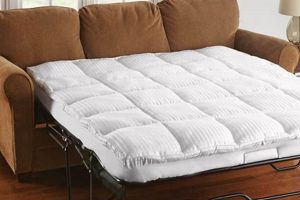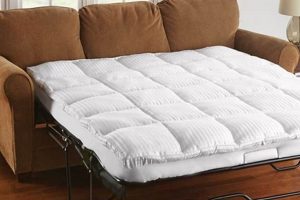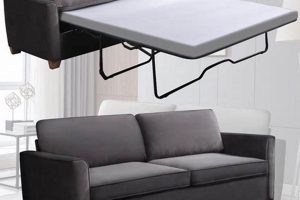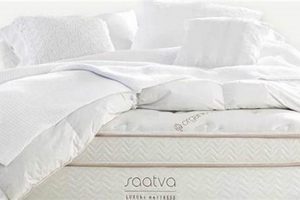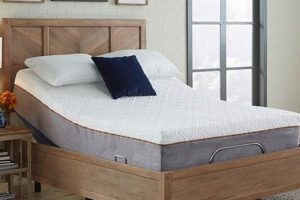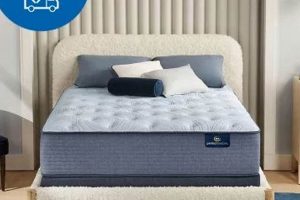A sleeping surface designed to facilitate close proximity between a parent and infant during sleep. These products aim to provide the benefits of bedside sleeping while maintaining a separate and defined space for the baby, often attaching securely to the adult’s bed. Examples include bedside bassinets and specially designed mattresses intended to bridge the gap between the adult bed and a safe sleep environment for the child.
Proximity during the initial months can foster bonding, ease nighttime feeding, and promote parental responsiveness. Historically, shared sleeping arrangements have been practiced in various cultures, adapting over time with evolving safety standards and understandings of infant sleep physiology. These sleeping arrangements offer convenience for parents, potentially reducing the need to leave the bedroom frequently during the night.
The subsequent discussion will explore aspects such as safety considerations, different types of products available, and guidelines for usage. Further details on material composition, size variations, and maintenance recommendations will also be provided.
Tips for Using a Co-Sleeping Solution
This section provides key guidelines to ensure the safe and effective use of a sleep product designed for close parental proximity during infant sleep.
Tip 1: Verify Compliance with Safety Standards: Prioritize products that adhere to established safety regulations, such as those set by relevant consumer protection agencies. Ensure the item has been independently tested and certified.
Tip 2: Ensure a Firm and Flat Surface: The sleep surface should be firm and flat to minimize the risk of suffocation. Avoid products with soft padding or inclines.
Tip 3: Secure Attachment to the Adult Bed: If the product is designed to attach to the adult bed, ensure a secure and stable connection, following the manufacturer’s instructions precisely.
Tip 4: Eliminate Gaps and Crevices: Check for and eliminate any gaps between the product and the adult bed to prevent the infant from becoming trapped.
Tip 5: Avoid Loose Bedding and Soft Objects: Refrain from using loose blankets, pillows, or soft toys within the infant’s sleep space to reduce the risk of SIDS.
Tip 6: Monitor Infant Positioning: Consistently place the infant on their back for sleep, as recommended by pediatric health organizations.
Tip 7: Consider Room Temperature: Maintain a comfortable room temperature to prevent overheating, which can be a risk factor for SIDS. Avoid overdressing the infant.
Adhering to these guidelines can contribute to a safer sleeping arrangement while facilitating close parental proximity. Prioritizing safety standards and proper usage will help to mitigate potential risks.
The following sections will delve into specific product types and address frequently asked questions related to this sleep arrangement.
1. Firmness
Firmness represents a critical characteristic in the context of a co sleeper mattress, directly influencing infant safety and sleep quality. An appropriate level of firmness mitigates potential risks, while insufficient firmness can pose significant hazards.
- Reduced Suffocation Risk
The primary function of a firm sleep surface is to minimize the risk of suffocation. Infants lack the motor skills to reposition themselves if their face becomes pressed against a soft surface, increasing the likelihood of airway obstruction. A firmer surface provides resistance, preventing the infant from sinking into the mattress and maintaining an open airway. This characteristic is especially relevant given the close proximity sleeping environment.
- Proper Skeletal Development
A sufficiently firm mattress supports healthy skeletal development. Infants’ spines are still developing, and a soft or sagging surface can contribute to improper alignment and potential musculoskeletal issues. A firm, flat surface provides the necessary support for proper spinal alignment and healthy growth.
- Minimizing Rolling Hazards
A firmer sleep surface reduces the likelihood of an infant unintentionally rolling over onto their stomach. While back sleeping is recommended to reduce the risk of Sudden Infant Death Syndrome (SIDS), some infants may roll onto their stomachs independently. A firm mattress makes this rollover more difficult, promoting a safer sleeping position.
- Compliance with Safety Standards
Regulatory bodies and pediatric health organizations often specify firmness requirements for infant mattresses, including those designed for close proximity sleeping arrangements. Compliance with these standards is essential to ensure that the product meets established safety criteria and has undergone rigorous testing to minimize risks. Failure to meet these standards can indicate a potentially hazardous product.
The multifaceted importance of firmness underscores its significance when selecting a sleeping surface for infant proximity arrangements. Choosing a co sleeper mattress with adequate firmness, confirmed through certifications and adherence to safety standards, is paramount in promoting infant well-being and minimizing sleep-related risks.
2. Breathability
Breathability is a pivotal consideration in the design and selection of a co sleeper mattress, directly influencing infant comfort and safety. The following points detail the crucial role breathability plays in mitigating potential risks associated with infant sleep environments.
- Regulation of Body Temperature
Infants possess a limited capacity to regulate their body temperature, rendering them vulnerable to overheating. A breathable co sleeper mattress facilitates air circulation, dissipating heat and minimizing the risk of hyperthermia. Materials with open-cell structures or enhanced ventilation promote effective temperature regulation, contributing to infant comfort and reducing the likelihood of heat stress.
- Reduction of Moisture Buildup
Prolonged contact with a damp sleep surface can irritate an infant’s skin and promote the growth of bacteria. Breathable materials allow moisture to evaporate, maintaining a drier and more hygienic sleep environment. This is especially critical in shared sleeping arrangements, where close proximity can increase humidity levels. Fabrics that wick away moisture further enhance this effect.
- Minimization of Carbon Dioxide Rebreathing
While less prevalent with appropriately designed products, inadequate breathability can theoretically contribute to the rebreathing of exhaled carbon dioxide. A mattress with sufficient airflow allows for the dispersion of exhaled gases, potentially reducing this risk. Materials that allow for unrestricted air movement are preferred.
- Promotion of Comfortable Sleep
A breathable mattress promotes more comfortable sleep by preventing overheating and minimizing moisture buildup. A comfortable infant is more likely to sleep soundly and undisturbed, reducing the likelihood of parental disruptions and promoting a more restful experience for both infant and parent.
The facets outlined above highlight the essential role breathability plays in ensuring a safe and comfortable sleeping environment within proximity sleeping arrangements. Careful consideration of material composition and design features that enhance airflow is paramount when selecting a co sleeper mattress, thereby minimizing risks and promoting optimal infant well-being.
3. Size
Dimensions are a fundamental consideration when selecting a co sleeper mattress, influencing its suitability for diverse bedroom configurations and parental preferences. The following points detail the significance of size in the context of these products.
- Compatibility with Bed Dimensions
The width and length of the mattress must align with the intended adult bed, particularly if the co-sleeper is designed to attach directly. A mismatch in dimensions can create gaps or instability, compromising safety and usability. Precise measurements of the adult bed are necessary to ensure a seamless and secure fit. Some models offer adjustable height settings to accommodate varying bed heights.
- Infant Growth and Development
The internal dimensions of the co-sleeper must accommodate the infant’s growth trajectory. A mattress that is too small will restrict movement and become unsuitable as the infant develops. Consider the projected lifespan of the product and choose a size that allows for comfortable accommodation for the recommended usage period, typically several months.
- Available Bedroom Space
The overall footprint of the co-sleeper must be compatible with the available space within the bedroom. Larger models may offer increased internal space but require more floor area, potentially impacting maneuverability and accessibility. Assess the room layout and available space before making a selection, considering other furniture and pathways.
- Portability and Storage
Dimensions also influence portability and storage convenience. Compact models are easier to transport and store when not in use, making them suitable for travel or occasional use. Consider whether portability is a priority and choose a size that balances internal space with ease of transport and storage.
Therefore, attention to dimensions is paramount when choosing a co sleeper mattress. Careful evaluation of compatibility with the adult bed, the infant’s growth, available space, and portability requirements will ensure a practical and safe sleeping arrangement. Failing to address these aspects can lead to safety hazards and a less-than-ideal sleep environment.
4. Attachment Security
Attachment security represents a crucial safety parameter when considering a sleep arrangement designed for close proximity between parent and infant. The integrity of the connection between the co-sleeper and the adult bed is paramount to prevent hazardous gaps and ensure structural stability.
- Prevention of Entrapment Hazards
A secure attachment mechanism is essential to eliminate any gaps or spaces between the co-sleeper and the adult mattress. Such gaps pose a significant entrapment hazard, where an infant could potentially become wedged, leading to suffocation or injury. Robust attachment systems, properly installed and regularly inspected, are necessary to mitigate this risk. Examples of secure systems include adjustable straps, clamps, and interlocking mechanisms specifically designed to maintain a flush connection, even with movement.
- Maintenance of Stable Sleeping Surface
A secure attachment ensures a level and stable sleep surface. If the co-sleeper detaches or shifts, it can create an uneven plane, increasing the risk of the infant rolling or falling out. The attachment system should be capable of withstanding typical movement and weight distribution. Rigorous testing and adherence to safety standards are critical to verify the stability of the connection under various conditions.
- Facilitation of Proximity Without Risk
The primary benefit of a co-sleeper is to provide close proximity between parent and infant during sleep. However, this proximity must not compromise infant safety. A secure attachment enables parents to reach and attend to their infant easily while minimizing the risk of accidental injury due to an unstable or poorly connected sleep surface. It allows for the benefits of co-sleeping without the dangers of bed-sharing on a conventional adult mattress.
- Adherence to Safety Standards and Regulations
Reputable co-sleeper manufacturers prioritize attachment security and undergo rigorous testing to meet established safety standards and regulations. Compliance with these standards, such as those set by consumer product safety organizations, provides assurance that the product has been designed and tested to minimize attachment-related risks. Independent certification further validates the product’s adherence to safety protocols.
The multifaceted nature of attachment security underscores its critical role in co-sleeper design and selection. Prioritizing products with robust and reliable attachment mechanisms ensures a safer sleeping environment, enabling the benefits of parental proximity without compromising infant well-being. Regular verification of the attachment system and adherence to manufacturer instructions are essential for maintaining a secure sleep arrangement.
5. Material Safety
Material safety is a paramount consideration in the design and selection of a co sleeper mattress, directly impacting infant health and well-being. The composition of the mattress must be carefully evaluated to minimize exposure to potentially harmful substances.
- Absence of Harmful Chemicals
Co sleeper mattresses should be free from volatile organic compounds (VOCs), phthalates, flame retardants, and other chemicals known to pose health risks. Infants are particularly vulnerable to the effects of these substances due to their developing systems. Exposure to VOCs, for instance, can trigger respiratory irritation and allergic reactions. Mattress manufacturers should provide certifications, such as GREENGUARD Gold, to demonstrate compliance with stringent chemical emission standards. For instance, polyurethane foam, a common mattress component, should be certified as low-VOC.
- Hypoallergenic Properties
The materials used in the construction of a co sleeper mattress should be hypoallergenic to minimize the risk of allergic reactions. Infants often have sensitive skin, and exposure to allergens, such as dust mites or certain synthetic fibers, can trigger skin irritation or respiratory issues. Natural materials like organic cotton or wool are often preferred for their inherent hypoallergenic properties. These materials should be processed without harsh chemicals to maintain their purity and minimize the potential for allergic reactions.
- Breathability and Airflow
Material safety also extends to the breathability and airflow characteristics of the mattress. The materials should allow for adequate air circulation to prevent overheating and reduce the risk of moisture buildup, which can create a breeding ground for bacteria and mold. Open-cell foam structures and breathable fabrics like organic cotton promote airflow and contribute to a safer sleep environment. Testing standards should verify the material’s capacity to dissipate heat and moisture effectively.
- Durability and Longevity
Safe materials should also exhibit durability and longevity to withstand regular use and cleaning without degrading or releasing harmful substances. Inferior materials may break down over time, releasing particles or chemicals that could be inhaled or absorbed through the skin. Rigorous testing for wear and tear, as well as resistance to cleaning agents, is essential to ensure the long-term safety of the mattress. High-quality materials, properly maintained, will minimize the risk of material degradation and subsequent exposure to potentially harmful substances.
In summation, careful consideration of material safety is critical when selecting a co sleeper mattress. Prioritizing products made from non-toxic, hypoallergenic, and breathable materials ensures a safer and healthier sleep environment for infants. Certifications and third-party testing provide valuable assurance of a product’s compliance with stringent safety standards.
6. Edge Support
Edge support, in the context of a co sleeper mattress, refers to the structural reinforcement along the perimeter of the sleeping surface. The primary function of edge support is to prevent compression or collapse of the mattress edges when weight is applied near the perimeter. This is particularly relevant in these sleeping arrangements due to the proximity of the infant to the edge of the mattress, where a lack of support could lead to rolling hazards or discomfort. Effective edge support systems typically involve high-density foam encasements, reinforced springs, or specialized edge guard designs. The presence of adequate edge support contributes directly to the overall safety and stability of the sleeping surface.
The absence of sufficient edge support can have several detrimental consequences. For example, an infant positioned near the edge of a co sleeper mattress with inadequate support may roll off the sleeping surface entirely. Furthermore, compression of the edge can create an uneven sleeping surface, potentially leading to discomfort or postural issues. Real-world examples illustrate that mattresses lacking edge reinforcement often exhibit sagging edges over time, compromising both safety and usability. A product with robust edge support can maintain its structural integrity throughout its lifespan, providing a consistently safe and comfortable sleeping environment for the infant.
In summary, edge support is a critical design element in co sleeper mattresses, directly impacting safety and structural integrity. Its presence reduces the risk of falls and maintains a level sleeping surface, promoting a secure and comfortable environment. Understanding the significance of edge support allows for informed purchasing decisions and the selection of products that prioritize infant well-being. This facet contributes to the broader goal of providing a secure and optimal sleep environment for infants in close proximity sleeping arrangements.
Frequently Asked Questions
The following questions address common concerns and provide informational insights related to this type of sleep arrangement. The answers presented are intended to offer clarity and guidance.
Question 1: How is the safety of a co sleeper mattress ensured?
Safety is primarily ensured through adherence to established safety standards, material composition, and design features. Look for certifications from recognized testing organizations and verify that the product is free from harmful chemicals.
Question 2: What is the appropriate age range for using a co sleeper mattress?
The appropriate age range varies depending on the specific product; however, these products are generally designed for infants from birth to approximately six months of age, or until the infant begins to push up on their hands and knees.
Question 3: How does one properly clean and maintain a co sleeper mattress?
Cleaning and maintenance instructions vary depending on the material composition of the product. Generally, it is advisable to use mild, non-toxic cleaning solutions and to follow the manufacturer’s guidelines regarding spot cleaning or machine washing, where applicable.
Question 4: What are the potential risks associated with using a co sleeper mattress?
Potential risks include suffocation due to soft bedding, entrapment in gaps between the product and the adult bed, and overheating. Adherence to safety guidelines and regular inspection of the product are critical to mitigate these risks.
Question 5: What features should one prioritize when selecting a co sleeper mattress?
Key features to prioritize include firmness, breathability, secure attachment mechanisms, and non-toxic material composition. Verification of compliance with safety standards is also essential.
Question 6: Does a co sleeper mattress eliminate the risk of Sudden Infant Death Syndrome (SIDS)?
A co sleeper mattress does not eliminate the risk of SIDS. However, using a firm, flat sleep surface, placing the infant on their back, and avoiding loose bedding can contribute to a safer sleep environment, consistent with recommendations to reduce SIDS risk.
Careful consideration of these questions and adherence to recommended safety guidelines can contribute to a safer sleep experience for both infant and parent.
The next section will explore the legal and regulatory landscape surrounding these products.
Conclusion
This exposition has meticulously explored the various facets of the co sleeper mattress, underlining its significance in facilitating close proximity during infant sleep. The examination encompassed critical features such as firmness, breathability, size, attachment security, material safety, and edge support, all essential for promoting infant well-being. Furthermore, the discussion addressed common inquiries and considerations, offering clarity and guidance for informed decision-making.
The responsible selection and use of a co sleeper mattress demand rigorous adherence to safety standards and informed evaluation of individual needs and circumstances. Prioritizing infant safety and well-being remains paramount. Continuing advancements in design and regulatory oversight are anticipated to further enhance the safety and efficacy of these products in the future, ensuring a safer sleep environment for infants.


